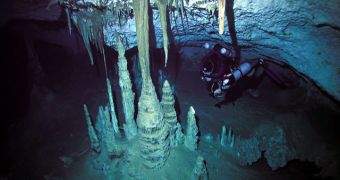A mysterious thick layer of blue pigment was often found at the bottom of many Maya sacrificial sinkholes, called cenotes. The Maya blue was employed for coloring offerings, pottery, murals, and even the victims of ritual sacrifices. The chemical composition of the pigment has been known for long; also its resistance to age, acid, weathering and chemical solvents.
"Unlike a lot of natural pigments that may fade, [Maya blue] is very stable," said Gary Feinman, curator of Mesoamerican anthropology at the Field Museum in Chicago, Illinois.
But how the Maya got the pigment was not known. A new research published on the journal Antiquity and led by Feinman's team explains this.
Lead author Dean Arnold of Wheaton College in Illinois noticed, on a pottery bowl from the Maya collection at the Field Museum, a wedge of incense with white flecks and the blue pigment.
The bowl had been recovered at the beginning of the 20th century at the bottom of the Sacred Cenote at the ancient Mayan city of Chich?n Itz?. That Cenote was dedicated to the rain god Chaak, and over 100 human sacrifices to that god were encountered in the sinkhole. The incense was copal, a tree sap commonly employed in Mesoamerica and whose smoke was thought to feed the gods.
The white flecks were of a white clay mineral named palygorskite. Previous studies had shown that Maya blue was achieved through the fusion of palygorskite with pigments coming from the leaves of the indigo plant. But how, as the two ingredients do not readily react? Now, it appears that the copal was the secret.
"Our study suggests that heat and copal incense likely were key elements used to fuse the two components together," Feinman said.
Indigo, palygorskite, and copal (all connected to healing) were individually employed as drugs by the Mayans. "The offering of three healing elements thus fed Chaak and symbolically brought him into the ritual in the form a bright blue color that hopefully would bring rainfall and allow the corn to grow again," said Arnold.
A 14-foot (4-m) layer of blue silt covered the bottom of the Sacred Cenote when first explored in 1904.

 14 DAY TRIAL //
14 DAY TRIAL //